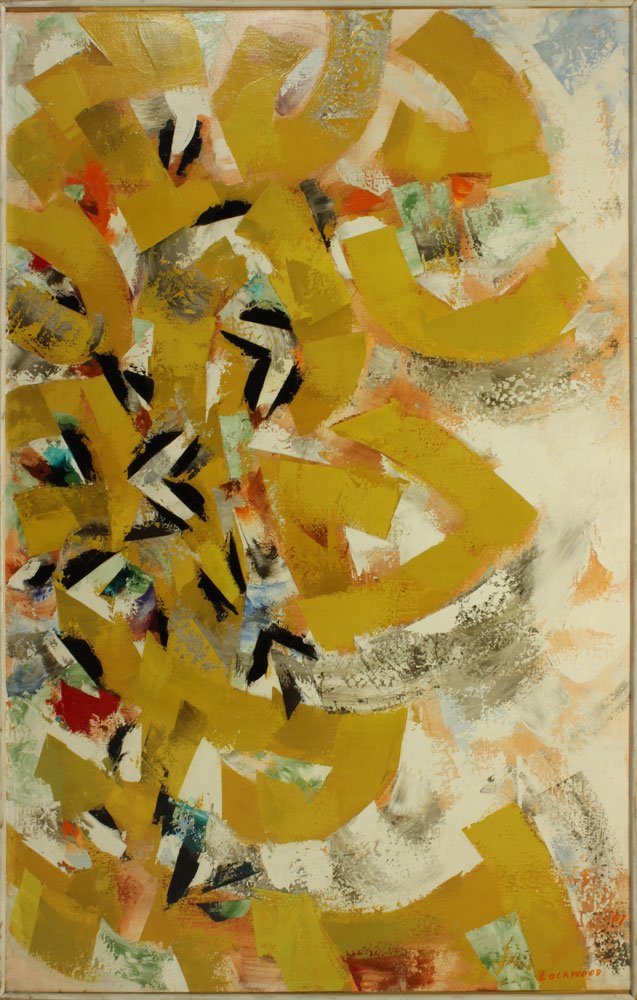Image Source: ADDISON ROWE GALLERYWARD LOCKWOOD
1894-1963
Ward Lockwood was a painter, illustrator, printmaker, and teacher. Throughout his career he employed many different styles ranging from Expressionism and Cubism to Surrealism and Constructivism.
Influenced by many great American painters, Lockwood’s work reflects the ever-changing American aesthetic of the 20th century.
Although his fame was overshadowed by many of the Taos artists of New Mexico, his influence was evident, and he was a key figure in the Taos community.
WARD LOCKWOOD BIOGRAPHY
-
Lockwood was born in Atchison, Kansas, September 22, 1894. He began working on the art staff of the Kansas City Star newspaper in 1912. He then studied at the University of Kansas from 1912-1914, and the Pennsylvania Academy of Fine Arts from 1914-1917. It was at the Academy that he was first introduced to Modernist art. He enlisted in the army in 1917 and served in France for two years.
In 1921, he returned to France with the intention of Studying art at the Academie Ranson. However he found the strict academic curriculum too stifling and decided to study art independently. Accompanied by fellow Kansan artist, Kenneth Adams, they toured around France, painting local models and visiting museums and galleries. Lockwood was impressed by the multifarious nature of contemporary art in Europe at the time, and elements of Geometric Abstraction, Futurism, and Impressionism began to permeate his work.
While traveling in France, Lockwood came to the same conclusion as many other American artists in Europe: an artist does his best painting in his own culture. Therefore, he returned to Kansas in1922 where he worked as a commercial artist and undertook various portrait commissions. In 1924 he married Clyde Bonebrake, who was also an artist. At the insistence of Kenneth Adams, he and his wife moved to Taos, NM in 1926. Although he traveled extensively, Lockwood maintained a residence in New Mexico for the rest of his life.
During his early years in Taos, Ward Lockwood spent most of his time fishing and painting with Kenneth Adams, Andrew Dasburg, and Loren Mozley. When John Marin visited Taos in 1929, he found and easy camaraderie with this group of fisherman-painters. Lockwood, who was already partial to using watercolors, was greatly inspired by Marin. These experiences encouraged Lockwood to develop a distinct modernist style of painting. At this time, he was commissioned to paint the Taos County Courthouse murals alongside Bert Philips and Victor Higgins.
Facing financial hardship in the 1930s, Lockwood left Taos in search of work. He completed several murals for the WPA, and in 1932, he began teaching painting and lithography at the Broadmoor Academy in Colorado Springs. In 1938, he accepted the position of Chair of the Department of Art at the University of Texas.
In 1942 he reenlisted to fight in WWII. His military obligations prevented him from producing any artwork during this period and he did not paint again until 1946. When he finally returned to his teaching position in 1947, Lockwood was dissatisfied with the creative atmosphere at the University of Texas, so he took a leave of absence to return to painting in New Mexico. However, his time in New Mexico was almost immediately interrupted when he accepted a teaching position at the University of California at Berkley the following year. While in California he exhibited with the Abstract-Expressionist painters of the San Francisco Art Association. Lockwood finally returned to Taos in 1962. He passed away the following year.
Over the course of his life, Lockwood was shown in over forty individual exhibitions. Following his death, the University of Texas Art Museum planned a retrospective exhibition that toured five different museums across America. Today his works can be seen in galleries and Museums across America, including the Whitney in New York and the San Francisco Museum of Modern Art. Although his name is somewhat unknown, Lockwood was a vital figure in the development of modern art in America.
Sources: Eldridge, Charles C. Ward Lockwood: 1894 – 1963. Kansas City: University of Kansas Museum of Art, 1974. Print. “Ward Lockwood.” AskART – Art Prices, Painting Value, Art Appraisal, Art Values, Auction. Prices. N.p., n.d. Web. 15 Nov. 2013.










Watercolor on paper
15 7/8 x 23 1/4 inches
Signed lower right
INQUIRE